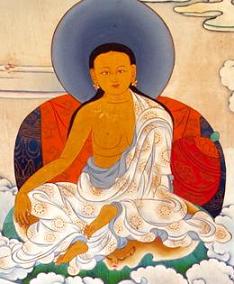Milarepa: Difference between revisions
mNo edit summary |
No edit summary |
||
| Line 5: | Line 5: | ||
Based on [[Alak Zenkar Rinpoche]]'s ''Short Commentary on the Eight Lineages of Practice''. | Based on [[Alak Zenkar Rinpoche]]'s ''Short Commentary on the Eight Lineages of Practice''. | ||
==Further Reading== | |||
*Garma CC Chang, ''The Hundred Thousand Songs of Milarepa'', Abridged edition, New York: Harper, 1962 | |||
[[Category:Historical Masters]] | [[Category:Historical Masters]] | ||
[[Category: Kagyü Masters]] | [[Category: Kagyü Masters]] | ||
Revision as of 18:49, 5 August 2008

Milarepa (Wyl. mi la ras pa) (1040-1123) was born in the Iron Dragon year of the first sexagenary cycle in a place called Kya Ngatsa in Gungtang in Upper Tibet. He first learned black magic and killed many enemies. Later, feeling remorse for his negative actions, he went to Lhodrak to meet the great Marpa Rinpoche. For about six years and eight months, Marpa made him undergo great hardship for the sake of the Dharma, such as building a nine storey tower, before he finally granted him all the empowerments and instructions. At the age of forty-five, in the Wood Mouse year (1084), he went to Upper Tibet, and for nine years, moved through Kyirong and Nyal. There he endured hardships, such as wearing only a simple cotton cloth and sustaining himself on nettles, and meditated with such fierce determination that he gained the supreme accomplishment within that very lifetime. Then he went to other places, coming and going, giving instructions of the secret mantra to those who were worthy disciples, and composing many songs of realisation. Among the many students he produced were Rechungpa and Dagpo Lhajé (Gampopa). He upheld the lineage of practice [of Marpa Rinpoche]. Finally, in the Water Hare year of the second sexagenary cycle, he departed.
Based on Alak Zenkar Rinpoche's Short Commentary on the Eight Lineages of Practice.
Further Reading
- Garma CC Chang, The Hundred Thousand Songs of Milarepa, Abridged edition, New York: Harper, 1962